sensor RENAULT ZOE 2016 1.G Owners Manual
[x] Cancel search | Manufacturer: RENAULT, Model Year: 2016, Model line: ZOE, Model: RENAULT ZOE 2016 1.GPages: 216, PDF Size: 6.48 MB
Page 44 of 216
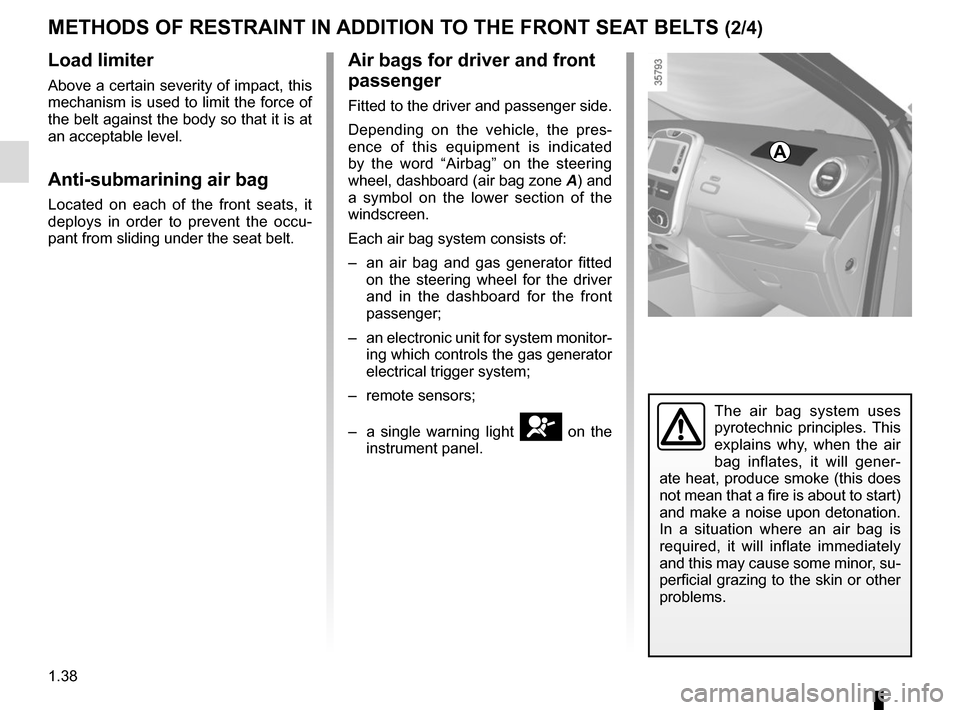
1.38
METHODS OF RESTRAINT IN ADDITION TO THE FRONT SEAT BELTS (2/4)
Load limiter
Above a certain severity of impact, this
mechanism is used to limit the force of
the belt against the body so that it is at
an acceptable level.
Anti-submarining air bag
Located on each of the front seats, it
deploys in order to prevent the occu-
pant from sliding under the seat belt.
Air bags for driver and front
passenger
Fitted to the driver and passenger side.
Depending on the vehicle, the pres-
ence of this equipment is indicated
by the word “Airbag” on the steering
wheel, dashboard (air bag zone A) and
a symbol on the lower section of the
windscreen.
Each air bag system consists of:
– an air bag and gas generator fitted on the steering wheel for the driver
and in the dashboard for the front
passenger;
– an electronic unit for system monitor- ing which controls the gas generator
electrical trigger system;
– remote sensors;
– a single warning light
å on the
instrument panel.
A
The air bag system uses
pyrotechnic principles. This
explains why, when the air
bag inflates, it will gener-
ate heat, produce smoke (this does
not mean that a fire is about to start)
and make a noise upon detonation.
In a situation where an air bag is
required, it will inflate immediately
and this may cause some minor, su-
perficial grazing to the skin or other
problems.
Page 79 of 216
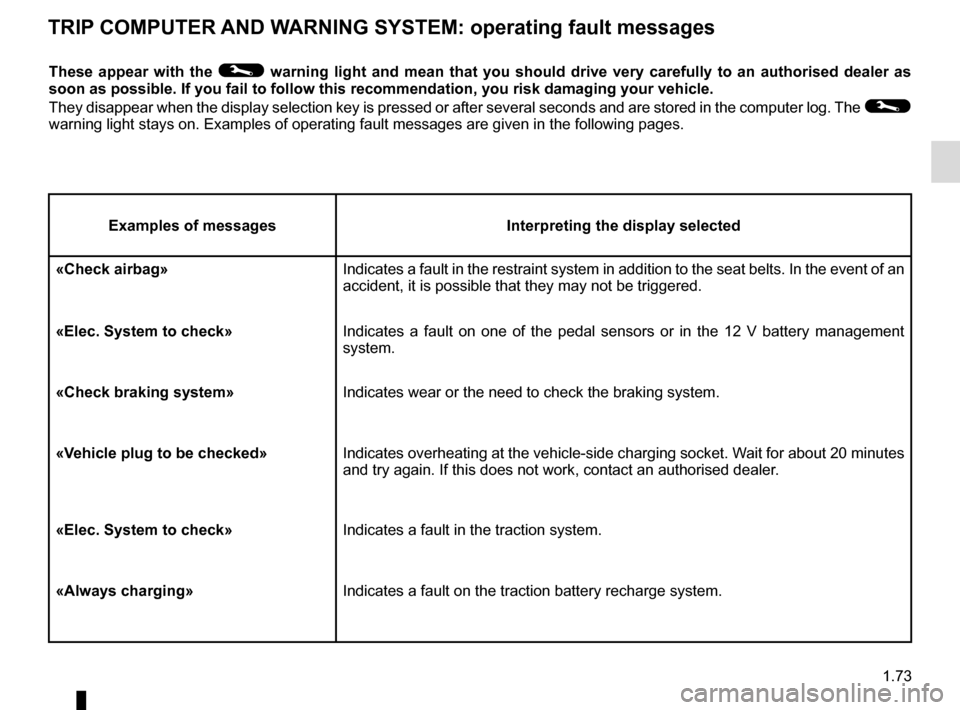
1.73
TRIP COMPUTER AND WARNING SYSTEM: operating fault messages
These appear with the © warning light and mean that you should drive very carefully to an author\
ised dealer as
soon as possible. If you fail to follow this recommendation, you risk da\
maging your vehicle.
They disappear when the display selection key is pressed or after severa\
l seconds and are stored in the computer log. The
©
warning light stays on. Examples of operating fault messages are given i\
n the following pages.
Examples of messages Interpreting the display selected
«Check airbag» Indicates a fault in the restraint system in addition to the seat belts.\
In the event of an
accident, it is possible that they may not be triggered.
«Elec. System to check» Indicates a fault on one of the pedal sensors or in the 12 V battery man\
agement
system.
«Check braking system» Indicates wear or the need to check the braking system.
«Vehicle plug to be checked» Indicates overheating at the vehicle-side charging socket. Wait for about 20 minutes
and try again. If this does not work, contact an authorised dealer.
«Elec. System to check» Indicates a fault in the traction system.
«Always charging» Indicates a fault on the traction battery recharge system.
Page 105 of 216
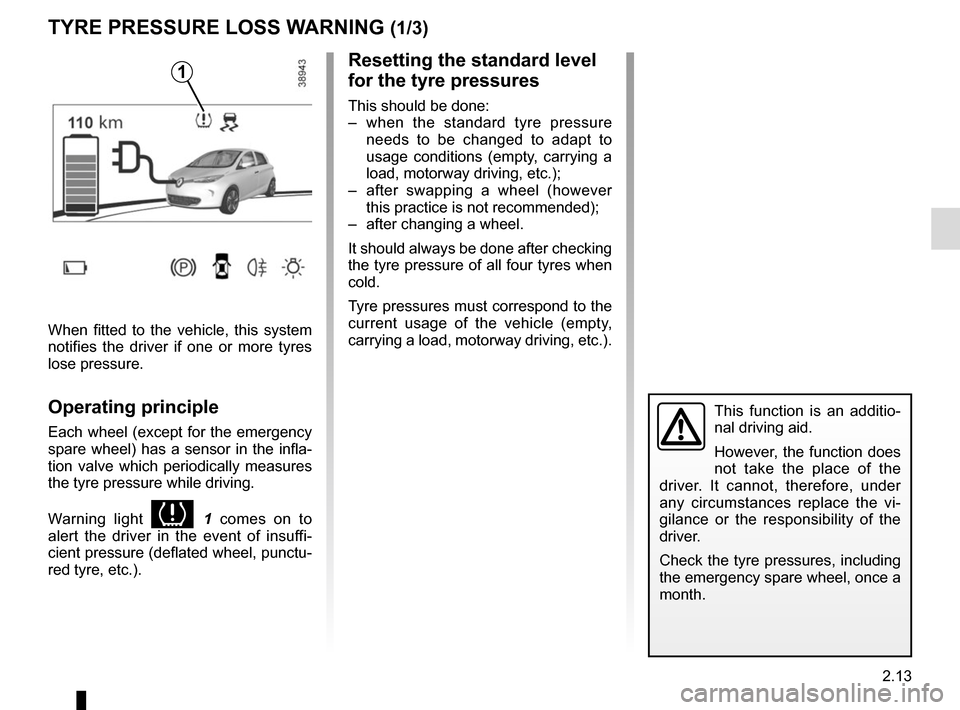
2.13
TYRE PRESSURE LOSS WARNING (1/3)
1
When fitted to the vehicle, this system
notifies the driver if one or more tyres
lose pressure.
Operating principle
Each wheel (except for the emergency
spare wheel) has a sensor in the infla-
tion valve which periodically measures
the tyre pressure while driving.
Warning light
1 comes on to
alert the driver in the event of insuffi-
cient pressure (deflated wheel, punctu-
red tyre, etc.).
Resetting the standard level
for the tyre pressures
This should be done:
– when the standard tyre pressure needs to be changed to adapt to
usage conditions (empty, carrying a
load, motorway driving, etc.);
– after swapping a wheel (however this practice is not recommended);
– after changing a wheel.
It should always be done after checking
the tyre pressure of all four tyres when
cold.
Tyre pressures must correspond to the
current usage of the vehicle (empty,
carrying a load, motorway driving, etc.).
This function is an additio-
nal driving aid.
However, the function does
not take the place of the
driver. It cannot, therefore, under
any circumstances replace the vi-
gilance or the responsibility of the
driver.
Check the tyre pressures, including
the emergency spare wheel, once a
month.
Page 107 of 216
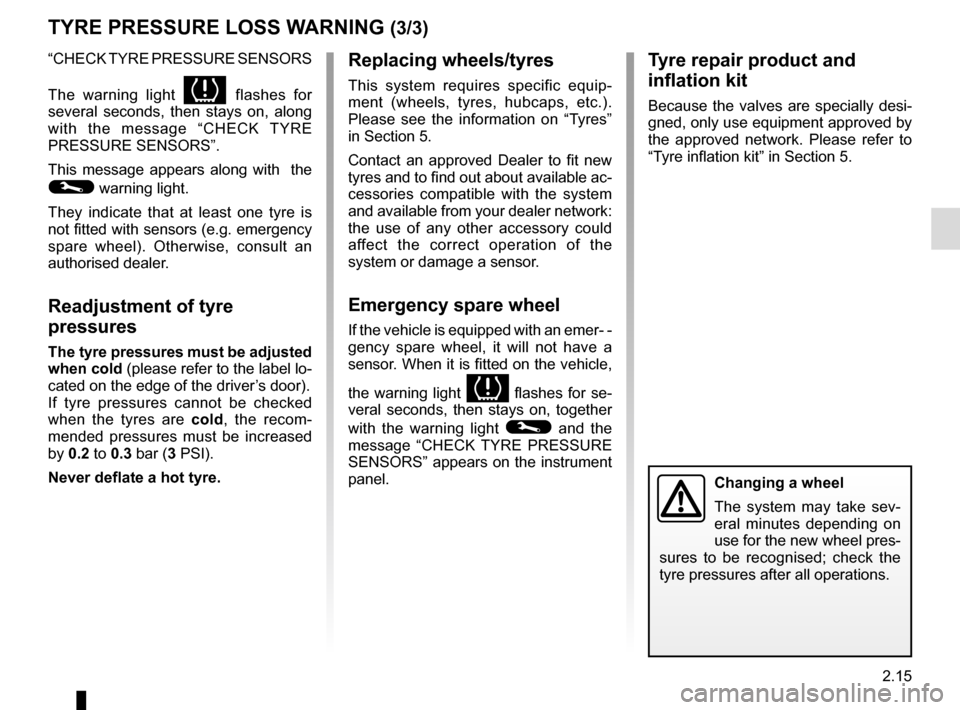
2.15
TYRE PRESSURE LOSS WARNING (3/3)
“CHECK TYRE PRESSURE SENSORS
The warning light
flashes for
several seconds, then stays on, along
with the message “CHECK TYRE
PRESSURE SENSORS”.
This message appears along with the
© warning light.
They indicate that at least one tyre is
not fitted with sensors (e.g. emergency
spare wheel). Otherwise, consult an
authorised dealer.
Readjustment of tyre
pressures
The tyre pressures must be adjusted
when cold (please refer to the label lo-
cated on the edge of the driver’s door).
If tyre pressures cannot be checked
when the tyres are cold, the recom-
mended pressures must be increased
by 0.2 to 0.3 bar (3 PSI).
Never deflate a hot tyre.
Changing a wheel
The system may take sev-
eral minutes depending on
use for the new wheel pres-
sures to be recognised; check the
tyre pressures after all operations.
Tyre repair product and
inflation kit
Because the valves are specially desi-
gned, only use equipment approved by
the approved network. Please refer to
“Tyre inflation kit” in Section 5.
Replacing wheels/tyres
This system requires specific equip-
ment (wheels, tyres, hubcaps, etc.).
Please see the information on “Tyres”
in Section 5.
Contact an approved Dealer to fit new
tyres and to find out about available ac-
cessories compatible with the system
and available from your dealer network:
the use of any other accessory could
affect the correct operation of the
system or damage a sensor.
Emergency spare wheel
If the vehicle is equipped with an emer- -
gency spare wheel, it will not have a
sensor. When it is fitted on the vehicle,
the warning light
flashes for se-
veral seconds, then stays on, together
with the warning light
© and the
message “CHECK TYRE PRESSURE
SENSORS” appears on the instrument
panel.
Page 109 of 216

2.17
Electronic stability program
ESC with understeer control
and traction control
Electronic stability control ESC
This system helps you to keep control
of the vehicle in critical driving condi-
tions (avoiding an obstacle, loss of grip
on a bend, etc.).
Operating principle
A sensor in the steering wheel detects
the direction selected by the driver.
Other sensors throughout the vehicle
measure the actual direction.
The system compares driver input to
the actual trajectory of the vehicle and
corrects the trajectory if necessary by
controlling the braking of certain wheels
and/or engine power. In the event that
the system is engaged, indicator light
flashes on the instrument panel.Understeer control
This system optimises the action of the
ESC in the case of pronounced under-
steer (loss of front axle road holding).
Traction control
This system helps to limit wheelspin of
the drive wheels and to control the ve-
hicle when pulling away accelerating or
decelerating.
Operating principle
Using the wheel sensors, the system
measures and compares the speed of
the drive wheels at all times and slows
down their over-rotation. If a wheel is
starting to slip, the system brakes au-
tomatically until the drive supplied be-
comes compatible with the level of grip
under the wheel again.
Operating faults
When the system detects an operat-
ing fault the message “Check ESC” and
warning light
© appear on the in-
strument panel. In this case, the ESC
and traction control system are deacti-
vated.
Consult an approved dealer.
DRIVER CORRECTION DEVICES AND AIDS (2/4)
Page 120 of 216
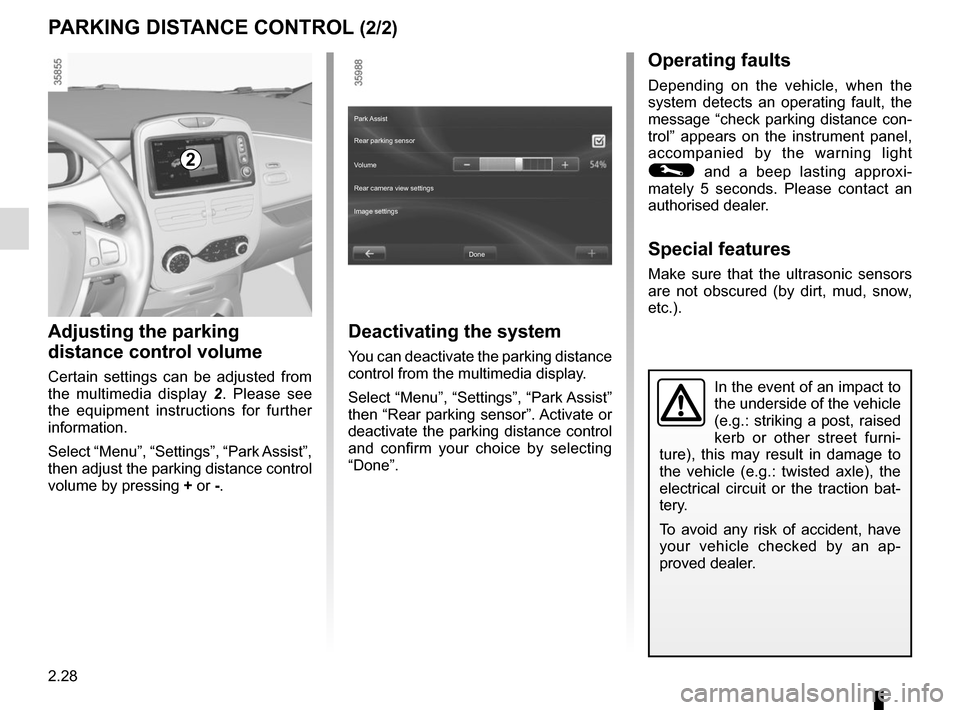
2.28
PARKING DISTANCE CONTROL (2/2)
In the event of an impact to
the underside of the vehicle
(e.g.: striking a post, raised
kerb or other street furni-
ture), this may result in damage to
the vehicle (e.g.: twisted axle), the
electrical circuit or the traction bat-
tery.
To avoid any risk of accident, have
your vehicle checked by an ap-
proved dealer.
Operating faults
Depending on the vehicle, when the
system detects an operating fault, the
message “check parking distance con-
trol” appears on the instrument panel,
accompanied by the warning light
© and a beep lasting approxi-
mately 5 seconds. Please contact an
authorised dealer.
Special features
Make sure that the ultrasonic sensors
are not obscured (by dirt, mud, snow,
etc.).
Adjusting the parking
distance control volume
Certain settings can be adjusted from
the multimedia display 2. Please see
the equipment instructions for further
information.
Select “Menu”, “Settings”, “Park Assist”,
then adjust the parking distance control
volume by pressing + or -.
2
Deactivating the system
You can deactivate the parking distance
control from the multimedia display.
Select “Menu”, “Settings”, “Park Assist”
then “Rear parking sensor”. Activate or
deactivate the parking distance control
and confirm your choice by selecting
“Done”.
Done
Park Assist
Rear parking sensor
Volume
Image settings Rear camera view settings
Page 122 of 216
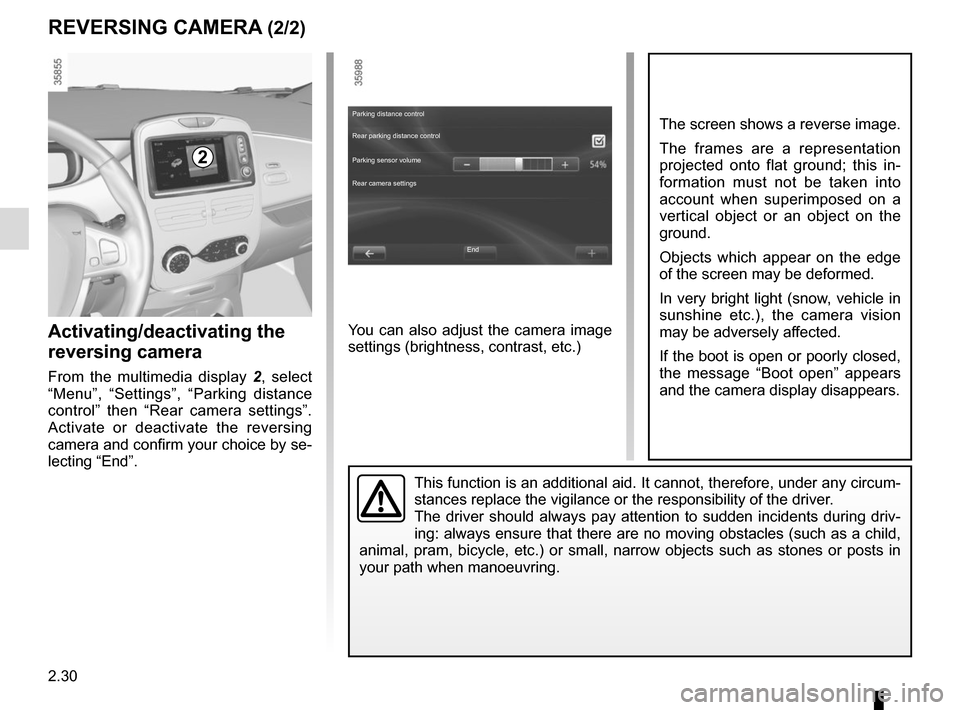
2.30
REVERSING CAMERA (2/2)
This function is an additional aid. It cannot, therefore, under any circ\
um-
stances replace the vigilance or the responsibility of the driver.
The driver should always pay attention to sudden incidents during driv-
ing: always ensure that there are no moving obstacles (such as a child,\
animal, pram, bicycle, etc.) or small, narrow objects such as stones or\
posts in
your path when manoeuvring.
The screen shows a reverse image.
The frames are a representation
projected onto flat ground; this in-
formation must not be taken into
account when superimposed on a
vertical object or an object on the
ground.
Objects which appear on the edge
of the screen may be deformed.
In very bright light (snow, vehicle in
sunshine etc.), the camera vision
may be adversely affected.
If the boot is open or poorly closed,
the message “Boot open” appears
and the camera display disappears.
Activating/deactivating the
reversing camera
From the multimedia display 2 , select
“Menu”, “Settings”, “Parking distance
control” then “Rear camera settings”.
Activate or deactivate the reversing
camera and confirm your choice by se-
lecting “End”.
2
You can also adjust the camera image
settings (brightness, contrast, etc.)
End
Parking distance control
Rear parking distance control
Parking sensor volume
Rear camera settings
Page 212 of 216

7.4
ALPHABETICAL INDEX (4/5)
RENAULT cardbattery ................................................................\
.......... 5.15
use ............................................................1.18 → 1.26, 3.8
RENAULT card battery ...................................................... 5.15
replacement parts ................................................................ 6.6
reverse gear selecting ................................................................ 2.5 – 2.6
reversing sensor ..................................................... 2.27 – 2.28
S
screen wash/wipe .............................................................. 1.86
seat belt pretensioners ..........................................1.37 → 1.40
front seat belt ...................................................1.37 → 1.40
seat belts ..................................1.33 → 1.40, 1.42 – 1.43, 1.63
see-me-home lighting ............................................... 1.81, 1.83
service sheets..........................................................\
6.7 → 6.12
side protection devices ...................................................... 1.42
signals and lights ...................................................1.80 → 1.83
speakers location ...............................................................\
......... 5.16
speed control .............................................................. 2.5 – 2.6
speed limiter .................................................1.63, 2.20 → 2.22
spoiler ................................................................\
................ 3.27
starting ...............................................................\
........2.2 → 2.4
starting the engine .....................................................2.2 → 2.4
steering wheel adjustment .............................................................\
...... 1.57
stopping the engine ............................................................. 2.4
storage compartment.............................................3.19 → 3.21
storage compartments ...........................................3.19 → 3.21
sun visor ........................................................................\
.... 3.18
T
tailgate ...............................................................\
................ 3.27
tanks and reservoirs brake fluid ...................................................................... 4.5 coolant ................................................................\
........... 4.4
tanks and reservoirs: windscreen washer ........................................................ 4.5
technical specifications ........................................................ 6.6
telephone ..............................................................\
............. 3.29
temperature regulation ..............................................3.4 → 3.7
tool kit ........................................................................\
.......... 5.2
towing in the event of energy failure ...........................5.19 → 5.21
breakdown .......................................................5.19 → 5.21
towing hitch...................................................... 5.2, 5.20 – 5.21
towing rings ................................................... 1.47 – 1.48, 3.28
traction battery ...........................................................1.2 → 1.6
traction battery charge .............................................1.8 → 1.15
traction control .......................................................2.16 → 2.19
transporting children ..........................1.44 – 1.45, 1.47 → 1.56
transporting objects in the luggage compartment ............................. 3.27 – 3.28
trip computer and warning system.........................1.67 → 1.74
tyre inflation kit......................................................\
.....5.3 → 5.5
tyre pressure............................................2.13 → 2.15, 4.8, 5.7
tyre pressure loss warning.....................................2.13 → 2.15
tyre pressures ...................................................................... 4.8
tyres .............................................. 2.13 → 2.15, 4.8, 5.6 → 5.8
U
unlocking the doors ................................................ 1.29 – 1.30
V
vehicle range ........................................................... 2.7 → 2.11
ventilation ............................................................\
......3.4 → 3.7
W
warning buzzer ..................................... 1.27 – 1.28, 1.78, 1.81
warning lights.....................................1.62 → 1.64, 1.67 – 1.68
washing .................................................................... 4.9 – 4.10